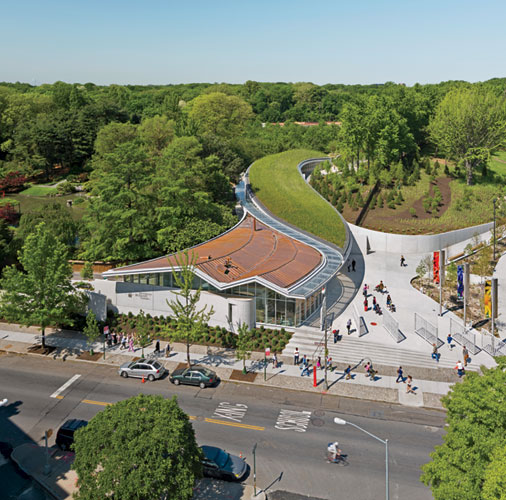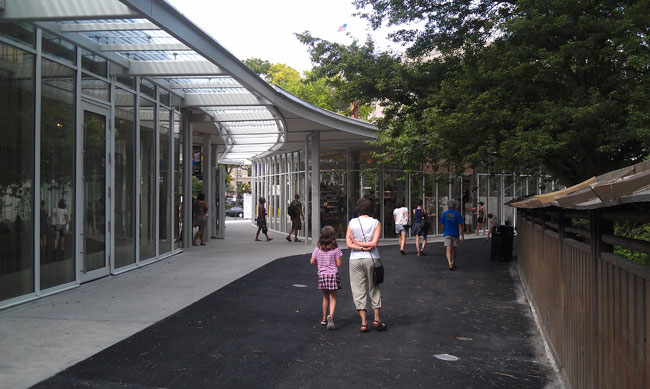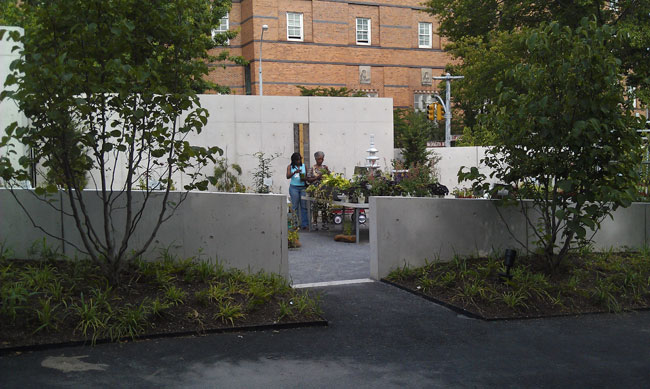Brooklyn Botanic Garden Visitor Center
Groundswell: Earth and plants serve as critical materials in helping a building integrate itself into the landscape.


































Architects & Firms
New York City
At a time when green roofs have become a cliché and landscape a term used to describe almost anything, how do you design a building for a botanic garden without looking like a wannabe? Marion Weiss and Michael Manfredi'architects who have been fusing structure and site since they built the Women's Memorial and Education Center at Arlington National Cemetery in 1997'might not need to worry about jumping late on the green bandwagon, but in taking on the job of building a visitor center at the Brooklyn Botanic Garden (BBG), they faced the challenge of not repeating themselves.
Ironically, the answer for the husband-and-wife team began with an emphasis on the new building's urban character. In their first interview for the job, the architects told the client they wanted to move the proposed site from a leafy spot near the center of the 52-acre garden to one on the northeast side, facing a busy street. The original location placed the visitor center on axis with the garden's Cherry Walk, but Weiss and Manfredi argued that a building there might dominate the cherished esplanade of trees. It also would require visitors to walk along the edge of a large parking lot behind the Brooklyn Museum, BBG's Beaux-Arts neighbor to the north. Bringing the new building to the street would give it an urban presence, provide the chance for a graceful transition from city to nature, and protect the character of the garden itself. The argument immediately convinced the client's building committee, recalls Scot Medbury, president of BBG.
“The tension between being in an oasis and being in the city is what makes this project so wonderful,” says Weiss. So she and Manfredi chose to introduce the building to the street with a generous entry plaza and a copper sawtooth roof that will age to the same color as BBG's 1917 McKim, Mead & White administration building down the block. The jagged roof covers a garden shop that sells plants and books and can operate even when the garden is closed. What at first appears to be a single building addressing the street turns out to be a pair of structures separated by a fritted-glass-covered breezeway. Walk through that breezeway and you can continue along a path to the Cherry Esplanade or duck inside to the second building, this one topped by a 10,000-square-foot green roof planted with 40,000 grasses, spring bulbs, and wildflowers. The building uses earth and plants, along with glass and steel, as essential materials.
Pushed up against an existing berm, the visitor center houses a ticket booth, exhibits, a café, and restrooms, while connecting an allée of ginkgo trees on the ridge of the berm to the rest of the garden below. At the far end of the structure, a leaf-shaped atrium provides a double-height space for talks or social events. If you climb an outdoor stair that winds around this space, you come to a covered passage that offers a view down into the atrium and then continues to a terraced hillside at the base of the ginkgo allée.
The visitor center rambles along for 385 feet, nearly two city blocks. But because it unfolds as a set of buildings, it seems much shorter. “We wanted it to feel like a series of episodic events,” says Manfredi. By slicing views and passages through the buildings—creating a nuanced progression of outdoor, indoor, and covered spaces—the architects neatly threaded the visitor center into the landscape.
As they have done in almost all their projects, Weiss and Manfredi applied a number of sustainable design strategies to the visitor center. In addition to using the existing berm and the green roof to reduce solar loads, they employed a geo-exchange system of 28 thermal wells to heat and cool interior spaces, specified concrete and steel containing recycled building materials, and fabricated wood paneling in the event space from ginkgo trees cut down to make way for the building. According to the architects, the project is on track to earn LEED Gold certification.
Weiss and Manfredi also worked with landscape architect Henry M. White III to use the green roof and areas around the building to create a series of bioswales that filter stormwater and store it in a pair of rain gardens—one in the entry plaza and the other in the plaza outside the event atrium. “We wanted to show plants as an ecological system and get beyond just their beauty,” says White.
What makes the visitor center work so well as a piece of architecture is the way it expresses in glass, steel, and earth the natural and man-made forces shaping the site. Its slithering form and sinuous breezeway respond to the paths, trees, and berm that had long been there. “We tried to bring into view things that had been invisible in the site,” explains Weiss. So the circulation through the building offers views back to the city, out to Cherry Walk, and up to the ginkgo allée on the top of the berm—all of which were always there but probably weren't previously noticed by visitors as they walked through this part of the garden.
By alternating spaces that feel compressed—such as the curving gallery with exhibits by Thinc Design and the narrow passage cutting through the building at the upper level—with others that seem to expand, such as the event atrium, Weiss/Manfredi created a rhythmic progression that animates the architecture.
A few elements seem weaker than the whole. The outdoor stair curving around the glass facade of the atrium could have been more elegantly detailed to make it more ethereal. And a stucco wall with a small window facing the ginkgos on the upper level looks cheap. But these are quibbles. The visitor center stands as a remarkable addition to a 102-year-old institution's beloved campus, one that serves as a gracious threshold between the urban context and the gardens within, as well as between one era and another.
Completion Date: May 2012
Size: 22,000 square feet
Cost: $28 million
Architect and Site Design:
WEISS/MANFREDI
Architecture/Landscape/Urbanism
200 Hudson Street 10fl
New York NY 10013
PeopleOwner: Architect and Site Design: Personnel in architect's firm who should receive special credit: Project Architect/Manager: Additional Team Members: Interior designer: Engineer(s): MEPFP/IT: Consultant(s): Glazing: Sustainability/Commissioning: Geothermal/Geotechnical: Lighting: Acoustical/AudioVisual/Security: Exhibit: Food Service: Building and Fire Code: Concrete: Waterproofing: Retail: Building Department: Specifications: Construction Management: General contractor: Photographer(s): Renderer(s): WEISS/MANFREDI CAD system, project management, or other software used: |
ProductsStructural system: Architectural exposed steel: Canatal Industries Architectural concrete: J.M.R Concrete Corp, Doka USA Exterior cladding: Moisture barrier and waterproofing: Henry, Carlisle Curtain wall: Shuco USA Roofing Green roof planting: New York Green Roofs Copper standing seam: Firestone, Universal Services Group Metal coping: W.P. Hickman Other: W.R. Grace Glazing Curved glass: Precision Glass Bending Other: JE Berkowitz Doors Metal doors: Curries Wood doors: Mohawk Interior glass doors: Doralco Hardware Closers: Dorma Exit devices: Dorma, Sargent Pulls: Custom, Elmes Interior finishes Suspension grid: USG Cabinetwork and custom woodwork: Prospec Interiors Paints and stains: Tnemec, Benjamin Moore Plastic laminate: Pionite Cast stone surfacing: Icestone Glass wall tile (Restrooms): Viscaya Glass Floor and wall tile (Kitchen and Bathrooms): Daltile Resilient flooring: Forbo Wood flooring: Solid white oak, Haywood Berk Carpet: Bentley Prince Street Concrete topping: LM Sealhard Special interior finishes unique to this project: Site harvested wood veneers Furnishings Reception chairs: Chair Factory Pedrali Exterior benches: Landscapeforms Café tables and chairs: M2L Arper Lounge furniture: Knoll Custom furniture (Weiss/Manfredi): Vyeko, St. John Woodworking Lighting Downlights: Kurt Versen Task lighting: Haworth Exterior: Bega, BK Lighting, Elliptipar Dimming System or other lighting controls: Lutron, Douglas Conveyance Material Lift: Gillespie Plumbing Water fountains: Halsey Taylor High-efficiency water heater and boiler: AO Smith, Lochinvar Energy Energy HVAC management: York/Johnson Controls, Data Aire Radiant heat system: Viega Building automation system: Andover Controls, Schneider Electric Other unique products that contribute to sustainability: Stabilized paving: Stabilizer Solutions Trench drain grates: Iron Age Engineered growing media: The Dirt Company Plants nusery: Thievon, Moon, Halka, Pinelands, Rivendell, Schichtel, Sylva Native, Tuckahoe, Waynesboro, Mahoney, Bigelow, Outback, Sunny Borders |




















